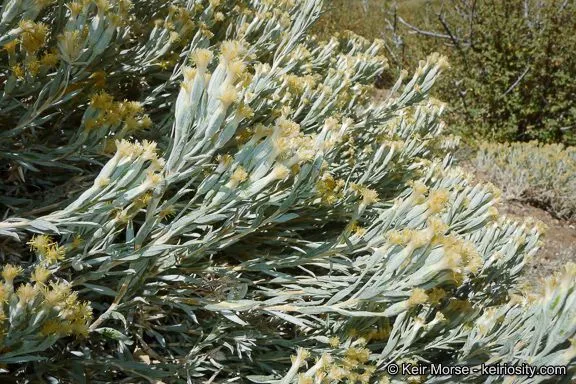
Author: DC.
Bibliography: Prodr. 6: 440 (1838)
Year: 1838
Status: accepted
Rank: species
Genus: Tetradymia
Vegetable: False
Observations: W. Canada to W. & WC. U.S.A.
The Common horshbrush, scientifically known as Tetradymia canescens, is a notable species within the Asteraceae family. Initially described in 1838 by the esteemed botanist DC., this plant has carved a niche for itself in the diverse flora encompassing Western Canada, as well as the Western and West-Central regions of the United States.
Tetradymia canescens is characterized by its distinctive morphology, comprising dense, woolly foliage that imparts a silvery-gray hue, a feature that potentially aids in minimizing water loss through evapotranspiration. Such adaptations are particularly beneficial given the semi-arid to arid environments it typically inhabits. This species thrives in diverse habitats, often found in sagebrush deserts, pinyon-juniper woodlands, and open ponderosa pine forests, indicating its versatile ecological preferences.
The Common horshbrush blooms in summer, producing yellowish flowers that cluster together, enhancing their visibility to pollinators. Beyond its aesthetic appeal, this plant plays a significant role in its ecosystem, providing food and habitat for numerous native animal species. Furthermore, its roots help in soil stabilization, preventing erosion in the rugged terrains it often dominates.
Due to its resilience and ecological significance, Tetradymia canescens has been a subject of ongoing botanical research and conservation efforts. Studies focus on understanding its interaction with other species and its response to climatic changes, aiming to ensure the preservation of this remarkable plant for future generations.
Eng: common horshbrush, spineless horsebrush, grey horsebrush
Fra: tétradymie blanchâtre
En: Common horshbrush, Spineless horsebrush, GRAY HORSEBRUSH, Grey horsebrush
Fr: Tétradymie blanchâtre
Nv: Chʼį́įdiichʼil
Taken Jan 21, 2016 by EOL − Keir Morse (cc-by-nc-sa)
Taken Jan 21, 2016 by EOL − Keir Morse (cc-by-nc-sa)
Taken Jan 21, 2016 by EOL − Keir Morse (cc-by-nc-sa)
Taken Jan 21, 2016 by EOL − Keir Morse (cc-by-nc-sa)
Taken Jul 13, 2021 by Barb T (cc-by-sa)
Taken Sep 11, 2022 by overzealousbystrom (cc-by-sa)
Taken Oct 20, 2021 by Audrey Misner (cc-by-sa)
Taken Oct 24, 2019 by Maldonado Oscar Daniel (cc-by-sa)
Taken Sep 3, 2022 by Erika Mittermaier (cc-by-sa)
Taken Jan 21, 2016 by EOL − Keir Morse (cc-by-nc-sa)
Taken Jan 21, 2016 by EOL − Keir Morse (cc-by-nc-sa)
Taken Jan 21, 2016 by EOL − Keir Morse (cc-by-nc-sa)
Taken Jan 21, 2016 by EOL − Keir Morse (cc-by-nc-sa)
Taken Jan 21, 2016 by EOL − Keir Morse (cc-by-nc-sa)
Taken Jan 21, 2016 by EOL − Keir Morse (cc-by-nc-sa)
Taken Nov 21, 2012 by EOL − Steve Matson (cc-by-nc)
Taken Nov 21, 2012 by EOL − Steve Matson (cc-by-nc)
Taken Aug 23, 2015 by EOL − Steve Matson (cc-by-nc)
Taken Aug 23, 2015 by EOL − Steve Matson (cc-by-nc)
© copyright of the Board of Trustees of the Royal Botanic Gardens, Kew.
Growth form>: Multiple Stem
Growth habit>: Subshrub, Shrub
Growth rate>: Slow
Ph maximum: 8.0
Ph minimum: 7.0
Family: Myrtaceae Author: (F.Muell.) K.D.Hill & L.A.S.Johnson Bibliography: Telopea 6: 402 (1995) Year: 1995 Status:…
Family: Rubiaceae Author: Pierre ex A.Froehner Bibliography: Notizbl. Bot. Gart. Berlin-Dahlem 1: 237 (1897) Year:…
Family: Sapindaceae Author: Koidz. Bibliography: J. Coll. Sci. Imp. Univ. Tokyo 32(1): 38 (1911) Year:…
Family: Asteraceae Author: A.Gray Bibliography: Pacif. Railr. Rep.: 107 (1857) Year: 1857 Status: accepted Rank:…
Family: Fabaceae Author: Medik. Bibliography: Vorles. Churpfälz. Phys.-Ökon. Ges. 2: 398 (1787) Year: 1787 Status:…
Family: Aspleniaceae Author: (Cav.) Alston Bibliography: Bull. Misc. Inform. Kew 1932: 309 (1932) Year: 1932…